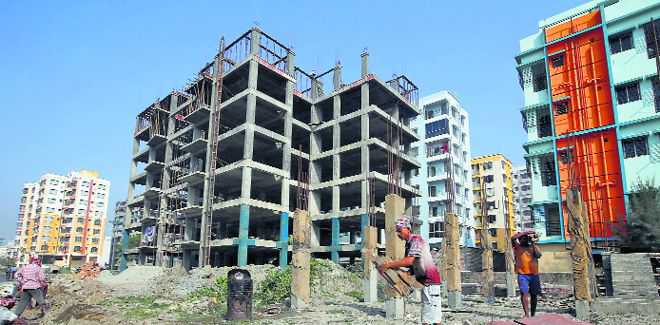
Slump: After the property price boom during 2001-07, there has been a decline in the demand in the real-estate sector.
Subir Roy
Senior Economic Analyst
THE Goods and Services Tax Council, comprising representatives of the Union and state governments, has lowered the GST rates across the board for housing under construction, seeking to spread cheer among home buyers and builders before the elections (there is no GST on completed housing projects as stamp duty comes into the picture).
GST on affordable housing is down from eight per cent to just one per cent. Plus, the ceiling value for affording housing has been raised to Rs 45 lakh from Rs 40 lakh. This comes almost a year after the rate for such housing was reduced from 12 per cent to eight per cent. GST on houses costing above Rs 45 lakh is also down sharply — from 12 per cent to 5 per cent.
The need to cut the tax element, particularly in affordable or low-cost property prices, has been widely felt as what the government takes away still makes up a huge 20 per cent of property values, though down from around 30 per cent three years ago.
These somewhat drastic changes have come in order to address the problem of unsold housing stocks with developers which now cover both the affordable and costlier categories. According to industry consultants ANAROCK, unsold affordable housing today makes up 34 per cent of the total under-construction stock of 5.88 lakh units in the top seven cities.
After the property price boom during 2001-07, there has been a decline in the real-estate demand with an all-time low being recorded in 2016. There are now many buyers who cannot get the price they paid for a property three years ago. This is attributed to two shocks which the industry experienced during 2016.
First came the enactment of the Real Estate Regulatory Agency legislation, which threw the industry into uncertainty until the states passed their own legislations. This initiated a period of wait-and-watch on the part of both buyers and sellers. Then came the big jolt of demonetisation later that year. It targeted black money, which plays a significant role in real- estate transactions.
The timing of the decision, just before a critical General Election, has its own logic. The demand for cash or black money increases in the run-up to an election; when this happens, people tend to postpone decisions regarding real estate. The sector then experiences a demand slump. This move will certainly cheer up developers.
But what is even more important for all political parties is that it is likely to boost the feel-good factor among voters too. There is, of course, the view that this move is another attempt by the ruling NDA at the Centre to reduce the supply of black money (people will rush to invest in housing), thus making it difficult for the opposition parties to garner cash.
Demonetisation was also seen as an attempt to deprive opposition parties of the flow of black money before the 2017 UP Assembly elections, but the two situations are not the same. The key element of the demonetisation decision was surprise, whereas the rate cut was widely anticipated.
The big issue, now that the rate cut has been announced, is what it will really amount to and correspondingly what impact it is likely to have. Critically, while lowering the GST rate, the council has disallowed input tax credit. This amounts to seeking to take away with one hand what it has sought to give with the other!
Earlier, a builder’s tax bill would be determined by his net tax liability: what he has to pay on the basis of what he has billed his buyers, minus what he has paid to his suppliers (the GST billed by them on his purchases). Builders and their representative bodies agree that since they cannot recover the GST paid by them by setting it off against their own tax liabilities, they will have to raise the prices. This means that buyers can undoubtedly look forward to paying less but not by as much that the reduction in the rates indicates. Still, the net price reduction for buyers, according to industry sources, can be around 6-7 per cent.
Not allowing input credit will, in fact, encourage the generation of black money. Builders will have no incentive to insist that their suppliers have proper GST registration and raise credible invoices. Only these can be used to claim write-offs. The government has said that rules being framed to go with the new rates will stipulate a minimum proportion of purchases by builders from registered suppliers. But the issue is, how will this be ensured by taxmen? They will have to undertake more rigorous inspection than would otherwise have been necessary. This will raise the transaction cost, as it is euphemistically called.
The question arises: if disallowing input write-offs detracts from the impact of the decision, why do it? The answer lies in the fact that both the Centre and the states, but more so the latter, are loath to give up a significant source of revenue. The states, in particular, do not have the revenue-generating flexibility that the Central government has. But still the usefulness of giving a fillip to the construction sector cannot be underestimated. It creates jobs and has in the years since liberalisation acted as a sponge to absorb migration from the countryside.
The ruling parties in the states are asking themselves: if the housing prices go down, will we be able to take the credit for it? Remember why the West Bengal government decided to pull out of the Ayushman Bharat healthcare scheme? A letter from Prime Minister Narendra Modi to the beneficiaries failed to mention that the state government was paying 40 per cent of the cost!



























